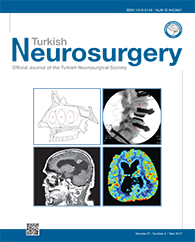MATERIAL and METHODS: Medical records were retrospectively reviewed in 73 cases of TCS who were underwent surgery in our hospital, between 2005 and 2014. Cases which diagnosed and treated surgically in adults (patient age > 18 years) were included in this study.
RESULTS: Twenty-three adult cases of TCSs were treated surgically and 15 of them were female and 8 were male. The mean age was 30.3±10.7 years. The mean follow-up period was 75.6±40.5 months. The most common complaint was low back pain. The most common findings in the neurological examinations were muscular weakness and urinary incontinence. The most common co-malformations were diastematomyelia and vertebral fusion anomalies. Conus medullaris was mostly terminated at the L5 level. Detethering procedure was carried out in 87% of patients and bony septum resection without detethering was applied in 13%. Laminoplasty was performed only in 39.1%. 60.9% of patients were recovered good. 34.8% of patients were improved. The most common complication was cerebrospinal fluid leakage.
CONCLUSION: Despite the good results obtained in our surgical interventions for symptomatic TCS in adults, tethered cord releasing is complex procedure and has serious complications. Therefore, it is suggested to plan surgery according to symptoms emphasized with full neurological examination, craniospinal imaging and urodynamic tests.
Keywords : Tethered cord syndrome, Dysraphic lesions, Scoliosis, Diastematomyelia, Laminoplasty, Intraoperative neurophysiological monitoring, Urodynamic test




